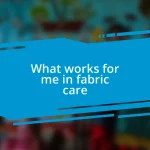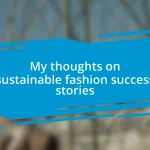Key takeaways:
- The author’s awareness of fashion ethics was sparked by discovering the exploitation of workers in sweatshops, leading to a passion for ethical consumerism.
- Researching ethical brands involves using resources like ethical directories, community engagement, and transparency in supply chains to make informed purchasing decisions.
- Advocacy for ethical fashion includes sharing experiences on social media and organizing clothing swaps to inspire others towards sustainability and ethical choices.

Understanding fashion ethics importance
Fashion ethics are crucial because they shape the way the industry impacts our world. I remember the first time I learned about sweatshops while browsing through my favorite clothing store. It hit me hard—how could I support a system that exploited workers? That moment ignited my passion for understanding the ethical implications behind my choices.
The importance of fashion ethics goes beyond just worker rights; it’s about the environment, too. I often find myself questioning: how does each garment I buy affect the planet? Exploring sustainable practices has not only opened my eyes but also prompted me to seek brands that prioritize eco-friendly materials and production methods. It’s empowering to know that my purchasing decisions can contribute to a healthier planet.
Balancing personal style with ethical considerations can feel daunting, but it’s incredibly rewarding. I’ve spent time curating a wardrobe filled with pieces that resonate with my values. Each time I wear an ethically made item, I feel a sense of pride and purpose. Isn’t it incredible to think that fashion can be a force for good?

Researching ethical fashion brands
Researching ethical fashion brands is a journey that requires patience and curiosity. I often dive into brand websites and social media profiles, looking for transparency about their supply chains. Recently, I came across a brand that openly shared their sourcing practices, including the names of factories they partner with. This level of transparency reassured me that they are committed to ethical production.
As I compare different brands, I’ve started using resources like ethical fashion directories and third-party certifications. For instance, when I discovered a brand was certified by Fair Trade, it made me feel more confident supporting them. I can’t help but smile when I think about the joy of wearing a dress that not only looks good but also does good. It’s like wearing a piece of empowerment!
Moreover, community engagement is something I prioritize during my research. Reading customer testimonials and checking for any community initiatives a brand supports helps me gauge their ethical stance. I recently joined an online forum where ethical fashion enthusiasts share their experiences, which has broadened my perspective. Have you ever wondered how other shoppers perceive the brands you like? In my case, discovering those insights has helped refine my choices even further.
| Brand | Ethical Certifications |
|---|---|
| Brand A | Fair Trade, GOTS |
| Brand B | B Corp, PETA Approved |
| Brand C | Sustainable Apparel Coalition |

Exploring sustainable fashion practices
Exploring sustainable fashion practices has become increasingly vital in today’s world. I remember attending a local sustainable fashion event where I was introduced to the concept of upcycling. The sheer creativity that came from reimagining old clothes into something fresh and stylish was awe-inspiring. It made me realize that sustainability doesn’t mean sacrificing style; rather, it can lead to unique and personal fashion statements.
Here are some sustainable practices that I’ve found particularly impactful:
- Upcycling: Transforming old garments into new pieces can be a fun and creative process.
- Sustainable materials: Fabrics like organic cotton, Tencel, and hemp minimize environmental impact.
- Local sourcing: Supporting brands that produce locally reduces carbon footprints from transportation.
- Capsule wardrobes: Curating a minimalist wardrobe encourages intentional buying and less waste.
- Second-hand shopping: Thrift stores and online resale platforms promote reusing clothing and finding unique treasures.
Integrating these practices into my fashion routine has not only been empowering but has deepened my appreciation for the journey behind each garment. I often find myself daydreaming about the stories woven into every piece—where it came from, who made it, and how it contributes to a broader movement towards sustainability. This connection fosters a sense of responsibility and joy in my personal style choices.

Engaging with fashion podcasts
Engaging with fashion podcasts has transformed the way I perceive the industry. I remember the first time I tuned into a podcast focused on sustainable fashion. The host dove deep into the stories behind brands, shedding light on their ethical practices and challenges. It felt like having a cozy chat with a friend who truly understands the complexities of fashion ethics.
Listening to podcasts allows me to absorb valuable insights while multitasking, whether I’m cooking or commuting. Some episodes resonate with me so deeply that I find myself reflecting on them long after. For instance, a recent discussion about the environmental impact of fast fashion not only educated me but also sparked a desire to change my own shopping habits. Have you ever found yourself unexpectedly inspired during a mundane task? That’s the magic of these conversations, and it’s exhilarating!
I also appreciate how podcasts can foster community. Following their social media channels often leads to engaging discussions with like-minded listeners. When I tweeted about an episode on circular fashion, I was thrilled to connect with others who shared similar sentiments. These interactions remind me that I’m part of a larger movement, making the journey towards ethical fashion feel even more fulfilling.

Participating in online fashion courses
Participating in online fashion courses has been a game-changer for me in understanding fashion ethics. I recall enrolling in a course on sustainable fashion last year, where the lectures opened my eyes to the intricate relationship between design and ethical practices. We explored everything from eco-friendly materials to fair labor practices, and I felt a mix of excitement and responsibility as I learned how my choices as a consumer matter.
What I love about online courses is the flexibility they offer. I can dive into lessons at my own pace, often while wrapped in a cozy blanket at home. One particularly engaging module had us analyze case studies of brands that successfully implemented ethical practices. I found myself eager to share my thoughts in the discussion forums, connecting with fellow students who were equally passionate about reshaping the industry. Have you ever come across a community that fuels your interest even further? It’s truly motivating!
These courses have not only enriched my knowledge but have also instilled a sense of confidence in my sustainable fashion journey. I’ve started applying what I’ve learned by questioning the brands I shop from and seeking out those that align with my values. It’s incredibly rewarding to engage more consciously with my wardrobe, knowing that every purchase reflects my commitment to fashion ethics.

Advocating for ethical fashion choices
Advocating for ethical fashion choices is, for me, not just an idea—it’s a commitment. I vividly remember the first time I stood in front of my closet and felt a pang of guilt knowing I had items that didn’t reflect my values. That moment led to a deep dive into the brands I supported. Have you ever felt unease in a pile of clothes you know don’t align with your principles? For me, it was a turning point that fueled my passion for nurturing a more thoughtful wardrobe.
One of the most impactful ways I’ve advocated for ethical fashion is by sharing my journey on social media. I still recall the day I posted about a local brand that uses recycled materials and supports fair wages. The responses were incredible! Friends began to ask questions and even started tagging me in their own sustainable fashion finds. It was like flicking on a light switch, illuminating a path for others to follow. Isn’t it amazing how a simple post can ignite conversations and inspire others to rethink their choices?
Lastly, I’ve found that talking to friends about ethical fashion choices can lead to meaningful changes. I often invite them over for a “clothing swap” party, which not only refreshes our wardrobes but also allows us to discuss why choosing secondhand or ethically-made clothing matters. During one gathering, a friend shared how she felt more connected to her clothes after learning their stories. It’s moments like this that remind me of the collective power we have when advocating for ethical practices—together, we can create waves of change.
















